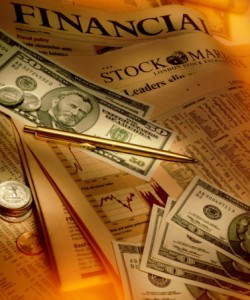 If you’ve ever wondered how the mechanics actually work, grab a hot cup of coffee, get comfortable in your favorite reading chair, and prepare to learn the basics of common stock. It's Simple, Really
If you’ve ever wondered how the mechanics actually work, grab a hot cup of coffee, get comfortable in your favorite reading chair, and prepare to learn the basics of common stock. It's Simple, Really
When you buy a share of stock, you are buying a piece of a company. Imagine that Harrison Fudge Company, a fictional business, has sales of $10,000,000 and net income of $1,000,000.
To raise money for expansion, the company’s founders approached a Wall Street underwriting firm (an investment banker) and had them sell stock to the public. They might have said, “Okay, we don’t think your growth rate is great so we are going to price this so that future investors will earn 9% on their investment plus whatever growth you generate…
that works out to around $11,000,000+ value for the whole company ($11 million divided by $1 million net income = 9% return on initial investment.)” Now, we’re going to assume that the founders sold out completely instead of issuing stock to the public.
The underwriters may say, “You know, we want the stock to sell for $25 per share because that seems affordable so we are going to cut the company into 440,000 pieces, or shares of stock (440,000 shares x $25 = $11,000,000.) That means that each “piece” or share of stock is entitled to $2.72 of the profit ($1,000,000 profit ÷ 440,000 shares outstanding = $2.72 per share.)
This figure is known as Basic EPS (short for earnings per share.) In other words, when you buy a share of Harrison Fudge Company, you are buying the right to your pro-rata profits. Were you to acquire 100 shares for $2,500, you would be buying $272 in annual profit plus whatever future growth (or losses) the company generated. If you thought that a new management could cause fudge sales to explode so that your pro-rata profits would be 5x higher in a few years, then this would be an extremely attractive investment.
What Makes It a Bit More Complicated
What muddies up the situation is that you don’t actually see that $2.72 in profit that belongs to you. Instead, management and the Board of Directors have a few options available to them, which will to a large degree determine the success of your holdings:
- It can send you a cash dividend for some portion or the entirety of your profit. This is one way to “return capital to shareholders.” You could either use this cash to buy more shares or go spend it any way you see fit.
- It can repurchase shares on the open market and destroy them. For a great explanation of how this can make you very, very rich in the long-run.
- It can reinvest the funds into future growth by building more factories, stores, hiring more employees, increasing advertising, or any number of additional capital expenditures that are expected to increase profits. Sometimes, this may include seeking out acquisitions and mergers.
- It can strengthen the balance sheet by reducing debt or building up liquid assets.
Which way is best for you? That depends entirely upon the rate of return management can earn by reinvesting your money. If you have a phenomenal business – think Microsoft or Wal-Mart in the early days when they were both a tiny fraction of their current size, paying out any cash dividend is likely to be a mistake because those funds could be reinvested at a high rate. There were actually times during the first decade after Wal-Mart went public that it earned more than 60% on shareholder equity. That’s unbelievable. Those kinds of returns typically only exist in fairy tales yet, under the direction of Sam Walton, the Bentonville-based retailer was able to pull it off and make a lot of associates and stockholders rich in the process.
Berkshire Hathaway pays out no cash dividends while U.S. Bancorp has resolved to return more 80% of capital to shareholders in the form of dividends and stock buy backs each year. Despite these differences, they both have the potential to be very attractive holdings at the right price (and particularly if you pay attention to asset placement) provided they trade at the right price. Personally, I own both of these companies as of the time this article was published and I’d be upset if USB started following the same capital allocation practices as Berkshire because it doesn’t have the same opportunities available to it as a result of the prohibition in place for bank holding companies.
The Two Ways You Make Money
Now that you see this, it’s easy to understand that your wealth is built in two distinct ways:
- An increase in share price. Over the long-term, this is the result of the market valuing the increased profits as a result of expansion in the business or share repurchases, which make each share represent greater ownership in the business as a percentage of total equity. In other words, if a business with a $10 stock price grew 20% for 10 years through a combination of expansion and share repurchases, it should be nearly $620 per share within a decade as a result of these forces assuming Wall Street maintains the same price-to-earnings ratio.
- Dividends. When earnings are paid out to you, these funds are now your property in that you can either use them to buy more stock or go to Vegas and blow it all at the craps table.
Occasionally, during market bubbles, you may have the opportunity to make a profit by selling to someone for more than the company is worth. In the long-run, however, the investor’s returns are inextricably bound to the underlying profits generated by the operations of the businesses which he or she owns.

Founder of Lazarus Enterprises Group and head of strategy at Apex Media 365, also Apex Marketing Pro, a leading digital marketing firm.
We developed a system to help small businesses, and local companies connect with potential clients, and customers who truly need their goods or services, which will in-turn increase the company’s net worth with a lot more ease, and control.
We do this utilizing Gorilla marketing tactics, and technology to measure a return on investment.
To schedule a free 30-minute Marketing Tune-up, call us: 1-888-256-4202
